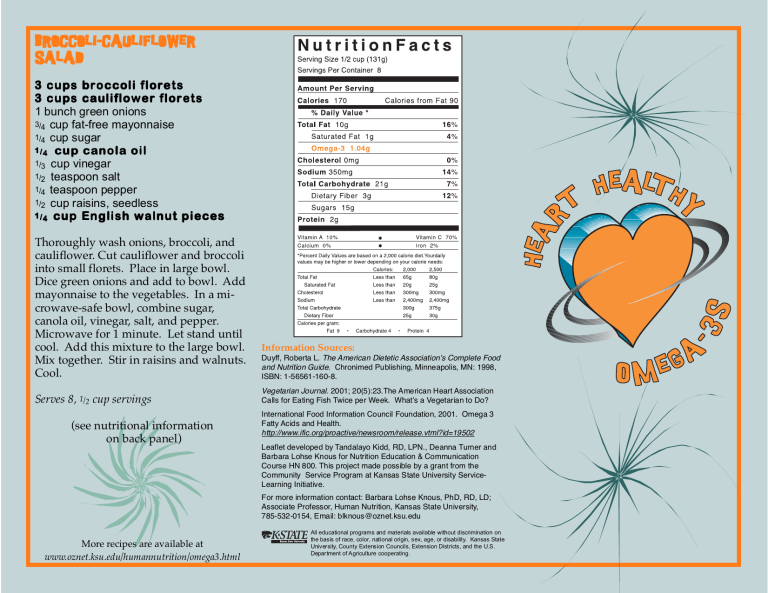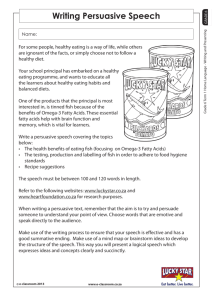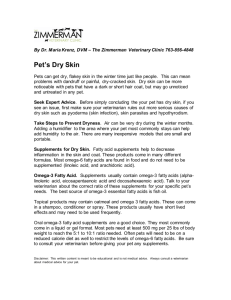Broccoli-Cauliflower Salad

1 bunch green onions
3/4 cup fat-free mayonnaise
1/4 cup sugar
1/3 cup vinegar
1/2 teaspoon salt
1/4 teaspoon pepper
1/2 cup raisins, seedless
Thoroughly wash onions, broccoli, and cauliflower. Cut cauliflower and broccoli into small florets. Place in large bowl.
Dice green onions and add to bowl. Add mayonnaise to the vegetables. In a microwave-safe bowl, combine sugar, canola oil, vinegar, salt, and pepper.
Microwave for 1 minute. Let stand until cool. Add this mixture to the large bowl.
Mix together. Stir in raisins and walnuts.
Cool.
Serves 8, 1/2 cup servings
(see nutritional information
on back panel)
More recipes are available at www.oznet.ksu.edu/humannutrition/omega3.html
Information Sources:
Duyff, Roberta L. The American Dietetic Association’s Complete Food and Nutrition Guide . Chronimed Publishing, Minneapolis, MN: 1998,
ISBN: 1-56561-160-8.
Vegetarian Journal . 2001; 20(5):23.The American Heart Association
Calls for Eating Fish Twice per Week. What’s a Vegetarian to Do?
International Food Information Council Foundation, 2001. Omega 3
Fatty Acids and Health.
http://www.ific.org/proactive/newsroom/release.vtml?id=19502
Leaflet developed by Tandalayo Kidd, RD, LPN., Deanna Turner and
Barbara Lohse Knous for Nutrition Education & Communication
Course HN 800. This project made possible by a grant from the
Community Service Program at Kansas State University Service-
Learning Initiative.
For more information contact: Barbara Lohse Knous, PhD, RD, LD;
Associate Professor, Human Nutrition, Kansas State University,
785-532-0154, Email: blknous@oznet.ksu.edu
All educational programs and materials available without discrimination on the basis of race, color, national origin, sex, age, or disability. Kansas State
University, County Extension Councils, Extension Districts, and the U.S.
Department of Agriculture cooperating.
e
H a r t
Healthy
O m e ga
- 3 s
Test your knowledge
Cardiovascular Disease is the leading cause of death in the United States for both men and women, regardless of race and ethnicity. Approximately one out of four Americans has some form of cardiovascular disease. Stroke and heart attack, two forms of cardiovascular disease, result when an abnormal function in the heart, arteries, or veins, interferes with oxygen flow to the brain or heart. Some risk factors that increase the chance of developing cardiovascular disease are smoking, high blood pressure, and high serum levels of LDL cholesterol.
Omega-3 Fatty Acids are an essential fat that may protect the body from heart disease in at least two ways.
1) They may stop blood clotting by preventing the platelets (cells responsible for clotting the blood) from sticking together.
2) Some studies have found that a diet rich in omega-3 fatty acids reduces the “bad” cholesterol (LDL; low-density lipoproteins) and increases the “good” cholesterol (HDL; high-density lipoproteins), thus decreasing the risk of atherosclerosis (plaque build up on artery walls).
Some Dietary Behaviors may decrease the risk of cardiovascular disease. Including foods that are rich or fortified with omega-3 fatty acids is one dietary intervention shown to lower the risk of cardiovascular disease.
Foods with omega-3 fatty acids can decrease blood clotting. If you are taking a blood thinning medication or dietary supplement consult your physician before increasing your intake of omega-3 rich foods or omega-3 supplements.
What is an Omega-3 Fatty Acid?
❋ An unsaturated fat that can
reduce clot formation and lower
LDL cholesterol.
Can you be healthy without
Omega-3 Fatty Acids?
❋ Not likely. All cells are dependent upon them for normal growth and
functioning.
What do fish, nuts, canola oil, broccoli, and spinach have in common?
❋ All have omega-3 fatty acids and
can be obtained from the diet.
What are other sources?
❋ Omega-3 fatty acids are found in wheat germ, canola oil, walnuts, cauliflower, green vegetables
(spinach, broccoli, and leafy greens), and marine foods (salmon, trout, tuna, herring, and sardines).
Please visit the Omega-3 Web site: www.oznet.ksu.edu/humannutrition/omega3.html





